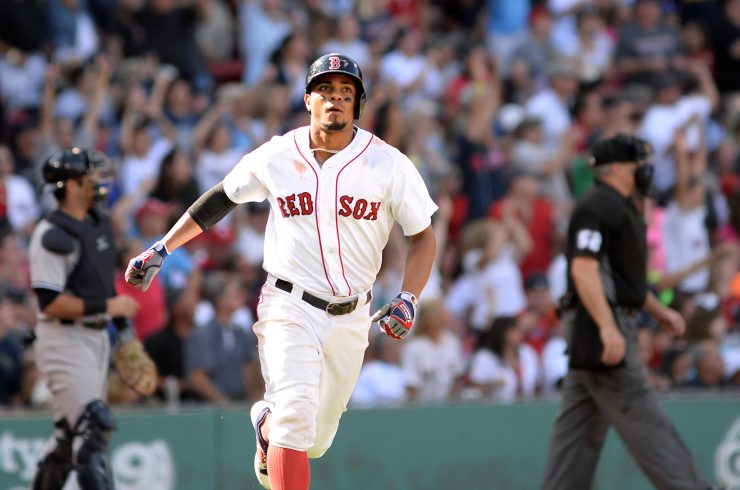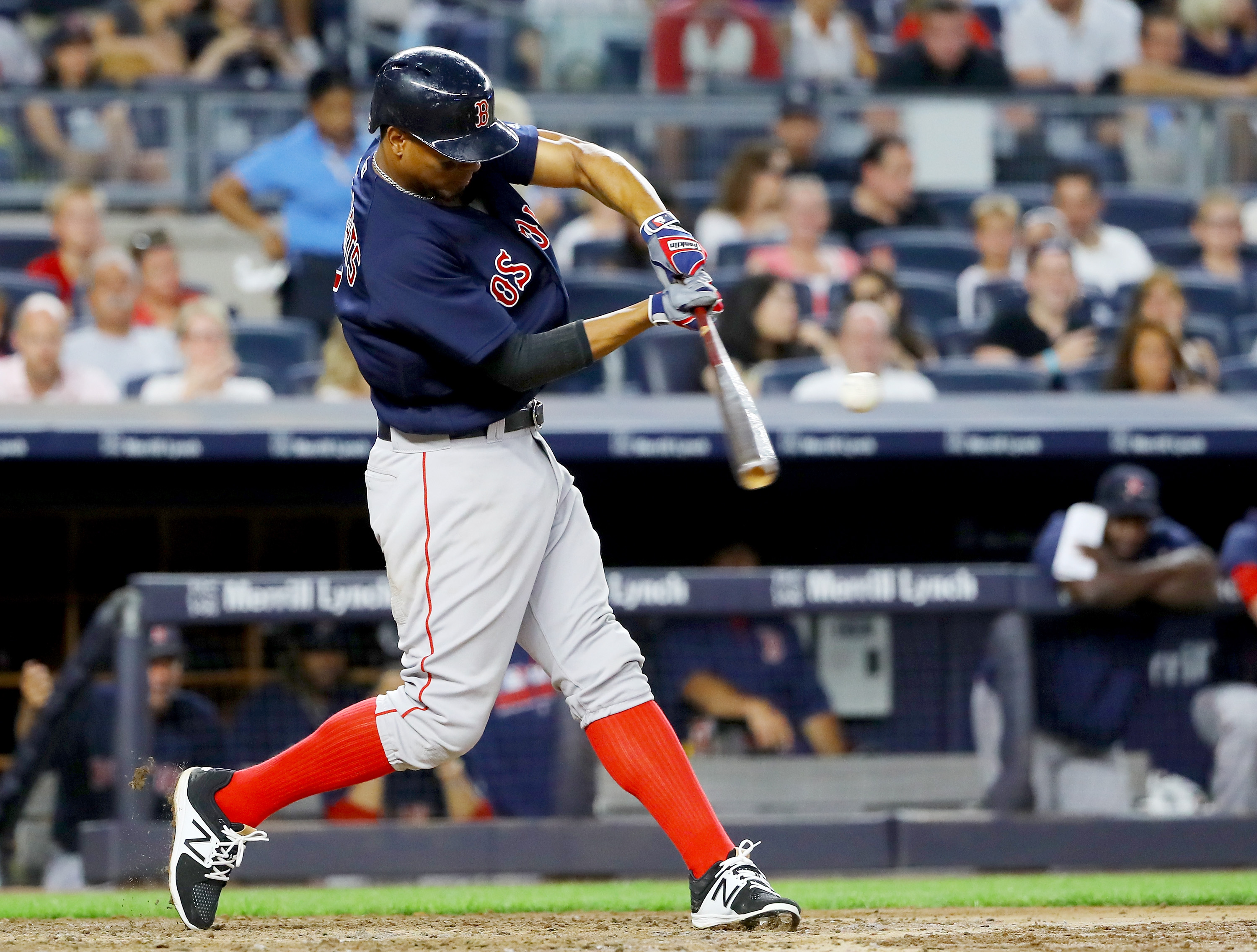The Boston Red Sox had one of MLB’s most potent offenses during the 2016 season, which was made possible because of a relentless lineup.
Anchored by the insane final year of David Ortiz’s career, manager John Farrell also had the joy of having Dustin Pedroia, a resurgent Hanley Ramirez, out-of-nowhere production from Sandy Leon, a full-year breakout from Jackie Bradley Jr. and an MVP-caliber season from Mookie Betts on his lineup card each night.
He also watched a stellar season from his young shortstop in Xander Bogaerts.
After hitting just 7 home runs to go along with 35 doubles in 2015, he tapped into some of that power potential by slugging a career-high 21 over the fence this past year, while his doubles output basically remained the same (34). This was also accompanied by a decent uptick in OPS (.776 to .802).
Despite 2016 serving as a breakout of sorts for Bogaerts, it didn’t come without the frustration of a prolonged slump that began in the middle of June and carried through to the end of the regular season.
Two Seasons in One
Between April 5 and June 11, Bogaerts looked like the dominant hitter Boston was waiting for – one that surpassed his 2015 home run total in just 279 plate appearances.
From June 12 through the end of the year, though? He looked like a shell of the hitter he just showed he could be.
| Timeframe | PA | Avg. | OBP | Slug% | ISO | HR | RBI | wRC+ |
|---|---|---|---|---|---|---|---|---|
| April 5-June 11 | 279 | .358 | .405 | .529 | .171 | 8 | 43 | 150 |
| June 12-October 2 | 440 | .253 | .325 | .392 | .139 | 13 | 46 | 90 |
To put this in perspective, his 150 wRC+ was on par with the season-long performances of Josh Donaldson (155) and Miguel Cabrera (152), while being slightly better than reigning NL MVP Kris Bryant (149) and reigning NL Rookie of the Year Corey Seager (137).
When using the 90 wRC+ he produced over the final 3.5 months, he was as productive as Scooter Gennett (91), Adonis Garcia (90) and Jordy Mercer (89).
That first wRC+ number would’ve tied for seventh highest in baseball if it held up all year, while the second one would’ve fallen outside the top 125 qualified hitters. Just a bit of a difference there.
So, what happened?
Plate Discipline
While Bogaerts did see a slight increase in strikeouts (15.4% to 17.1%), it was encouraging to see his walk rate spike back up from 4.9% to 8.1%. This was accompanied by swinging at fewer pitches out of the strike zone while making more contact inside the strike zone.
Those are all things we want to see.
However, you probably know what’s coming next – most of his progress in this area came during that torrid 2.5-month stretch where he was one of baseball’s best hitters.
| Timeframe | O-Swing% | O-Contact% | Z-Swing% | Z-Contact% |
|---|---|---|---|---|
| April 5-June 11 | 32.0% | 67.4% | 62.2% | 89.9% |
| June 12-October 2 | 34.9% | 68.9% | 57.3% | 91.3% |
His contact rate inside the strike zone actually increased during his slump, but it would’ve more encouraging if his swing rate in that situation also didn’t drop nearly five percentage points.
Although he chased more pitches in the latter part of the year, it wasn’t a huge difference from his earlier production. Plus, it’s not too far out of line with what Bogaerts has done throughout the early part of his career.
That leads us to another part of the conversation, which is finding out exactly how these balls were being put in play.
Batted Ball
What’s interesting between these two – admittedly arbitrary and not very even – halves from the young shortstop’s 2016 is the sharp decrease in ground balls and steady rise in fly balls.
Also, the fact that he didn’t benefit from it by way of improving his home-run-to-fly-ball ratio (HR/FB%).
| Timeframe | LD% | GB% | FB% | HR/FB% |
|---|---|---|---|---|
| April 5-June 11 | 20.3% | 50.9% | 28.8% | 13.1% |
| June 12-October 2 | 19.2% | 41.8% | 39.0% | 10.5% |
In addition to those changes, his quality of contact numbers help show why a such a prolonged slump wasn’t overly surprising.
| Timeframe | Soft% | Med% | Hard% |
|---|---|---|---|
| April 5-June 11 | 18.2% | 48.6% | 33.2% |
| June 12-October 2 | 22.0% | 49.1% | 28.9% |
Was he just regressing to the mean, though?
His 2015 performance (.320/.355/.421 in 654 plate appearances) can partly be attributed to what’s viewed as an unsustainable .372 BABIP. Although not many expected Bogaerts to maintain that number in 2016, he one-upped it during his early-season tear (.408 BABIP).
Of course, this peak was met with a valley, as is normally the case with baseball. He proceeded to post a .285 BABIP from June 12 through October 2, which would’ve been a career low had it happened over the course of an entire season.
While his overall BABIP was a healthy .335, we know the story — and the frustrations — behind exactly how he settled on that number.
Conclusion
Was this struggle purely a byproduct of bad luck? Well, yes and no – although there weren’t huge discrepancies in the above plate discipline and batted ball numbers (outside of BABIP) throughout 2016, he also didn’t improve all that much from his numbers in 2015.
However, it’s difficult looking at these numbers and saying he didn’t enjoy a good bit of fortune before coming back down to reality. Any team would take Bogaerts’ overall stats from last year (.294/.356/.446 with 21 homers, 89 RBI, 113 wRC+), but it’s just how he arrived there that was problematic.
If he continues making strides in improving his plate discipline (which shouldn’t be outrageous for a 24-year-old entering his fourth MLB season), it’ll be easier to not depend so much on such a high BABIP to be a consistent offensive producer.
The Red Sox will once again have a very good offense in 2017, but it’ll look much different without Ortiz in the middle of their order. His presence allowed other players to go through slumps without negatively impacting the team overall. Filling the void he’s leaving will be a team effort.
Without Big Papi around to keep things together when the offense isn’t firing on all cylinders, it’ll be up to Boston’s young core to take a step forward. For Bogaerts, that means improving his approach to gain some more consistency this season.
And judging from the kind of numbers he’s produced since the start of 2015, doing so will launch him even further into the elite conversation at shortstop — a conversation he’s already firmly a part of.
Statistics courtesy of Baseball-Reference. Advanced statistics courtesy of FanGraphs, unless otherwise noted.
Thanks for reading! If you’d like to jumpstart your sportswriting career and aren’t sure how, check out my eBook. Don’t forget to follow me on Twitter so we can chat about baseball: @mmusico8.
Add The Sports Daily to your Google News Feed!

